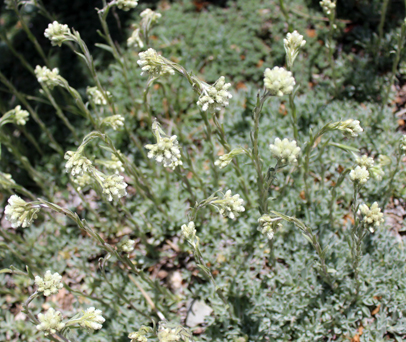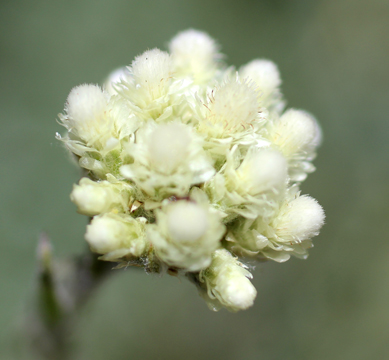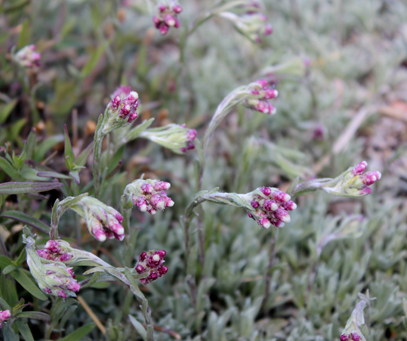Small-leaf white Pussytoes - Antennaria parvifolia
(Low everlasting, Nuttall's pussytoes)
 |
 |
The Plant w/flowers |
The Flowers |
Description
"Duration: Perennial Nativity: Native Lifeform: Forb/Herb General: Dwarf perennial herbs, to 8 cm tall, tomentose, not stipitate glandular, with wooly stolons; individuals staminate or pistillate, generally occurring equally in populations, however occasionally only pistillate individuals will be present. Leaves: Leaves mostly in a basal rosette, 1-nerved, obovate to spatulate, 5-9 mm wide, persistently tomentose abaxially, margins entire, caulescent leaves reduced, linear to oblanceolate, with acute apices. Flowers: Small discoid heads, staminate or pistillate, whitish, staminate corollas tubular, 5-toothed, pistillate corollas filiform, 8-10 mm or more high, involucres strongly graduated, phyllaries thin, membranaceous, distally white, pink, red, or brown, borne in corymbiform clusters in groups of 2-7 at the stem tips. Fruits: Achenes small, the pappus of the pistillate flowers of copious capillary bristles, pappus of the staminate flowers of clavellate, slightly flattened bristles. Ecology: Found in pastures, prairies, roadsides, parks, open woods, and drier coniferous forests, from 5,000-12,000 ft (1524-3658 m); flowering May-August. Distribution: This widespread species ranges from Manitoba to British Columbia, south to New Mexico and central Arizona. Notes: Pussytoes! Look for this species under Antennaria aprica. The keys to this species are the pistillate heads 8-10 mm or more high, the non-glandular inflorescence, and the abaxially tomentose leaves 5-9 m wide. Ethnobotany: This species was used in a variety of preparations to treat swellings, as a blood purifier, for the mad coyote bite, and as protection against witches, and the young leaves were used as greens. Etymology: Antennaria is from Latin antenna, because the flowers look like insect antennae, while parvifolia means small-leaved. Synonyms: Many, see Tropicos Editor: LCrumbacher 2011" (SEINet)
Red-tinted Pussytoes - Antennaria dioica 'Rubra'
 |
The Plant /w flowers |
Description
"A tough plant especially suited to hot sunny locations and poor, dry soil. This forms a very low, creeping mat of tiny, bright silvery-grey leaves. Short stems of fuzzy pink flowers appear in late spring. Perfect for the sunny rock garden, as a small groundcover, or for between paving stones. Also excellent growing in rock walls or in alpine trough gardens. Very drought tolerant. Easily divided in spring by simply ripping the clump apart into smaller pieces. Cut or mow off flower stems after blooming. Combines beautifully with any of the pink or purple Creeping Thyme selections. A North American native wildflower." (perennials.com)